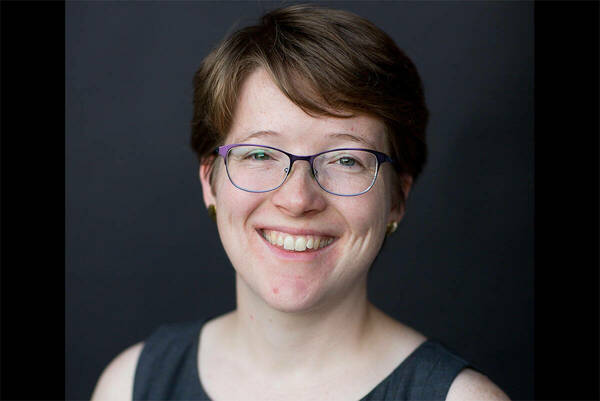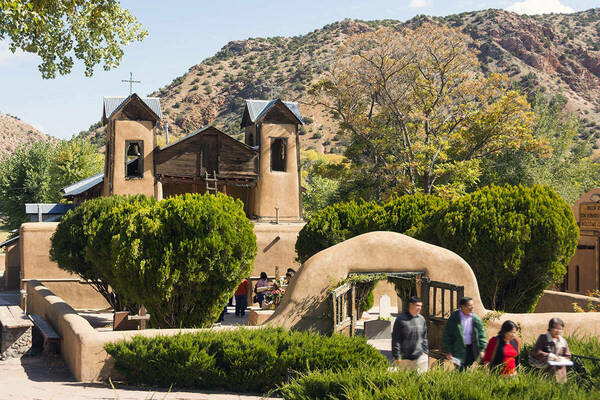
Melissa Coles joined the Cushwa Center in summer 2024 as a postdoctoral research associate. A historian of 19th- and 20th-century North America, Coles specializes in the intersection of Catholicism, Indigenous traditions, the environment, and sacred places. Her current research focuses on two Indigenous-Catholic pilgrimage sites: el Santuario de Chimayó, a shrine famous for healing dirt located in contemporary New Mexico, United States, and Lac Ste. Anne, a shrine renowned for healing water located in contemporary Alberta, Canada. Coles earned her Ph.D. in history from the University of Notre Dame, where she also received her B.A. in honors anthropology and peace studies. She earned her M.Div. at Harvard Divinity School. Before pursuing graduate studies, she worked for three years as a school librarian and teacher at Saint Michael Indian School.
In July, Shane Ulbrich corresponded with Coles about graduate school, her dissertation, and the year ahead.
Shane Ulbrich: Both Notre Dame and the Cushwa Center are well familiar to you, as a “double domer.” Tell us about your graduate school experience here at Notre Dame.
Melissa Coles: Wonderful, generous scholars shaped my Notre Dame graduate school experience. To name a few people and groups, I am grateful for the invaluable support and guidance of my advisor—Thomas Tweed—and my committee—Jon Coleman, Rosalyn LaPier, and Timothy Matovina. I found working groups that fostered space for growth and community—especially the Colloquium on Religion and History, the U.S. in the World Working Group, and the Women, Gender, and Sexuality History Working Group. I also was privileged to take part in the life of several institutes—including the Ansari Institute for Global Engagement with Religion, the Cushwa Center for the Study of American Catholicism, and the Kellogg Institute for International Studies. I believe that healthy communities are essential components of living a good life. So I search for and create community in all aspects of my life, and Notre Dame has been a generative intellectual community for me.
SU: Tell us about your dissertation. You recently defended, in April—congratulations! How did you arrive at the topic?

MC: Thank you! My dissertation, “Dirt, Water, and the Search for Healing: The Contested Histories of Indigenous-Catholic Holy Sites in the North American West, 1810–2022,” focuses on two pilgrimage places—el Santuario de Chimayó, a shrine famous for healing dirt in contemporary New Mexico, United States, and Lac Ste. Anne, a shrine renowned for healing water in contemporary Alberta, Canada. I examined these sites because I am interested in the histories of Catholicism, Indigenous traditions, the environment, and sacred places. These themes are interwoven throughout el Santuario de Chimayó and Lac Ste. Anne’s 19th-, 20th-, and 21st-century histories.
SU: What was your favorite chapter to write?
MC: Picking a favorite chapter is difficult! If I had to choose, though, I would say the final chapter of my dissertation was my favorite to research and write. That section covered the period of 1970 to 2022. I was able to bring together oral histories, archival research, and participant observation as the chapter’s source base. I think utilizing mixed methods creates a richer source base and more robust argument, and it is fun. For example, at the Catholic Historical Research Center of the Archdiocese of Philadelphia, I found documentation about a late-20th-century group undertaking a Chimayó pilgrimage for environmental reasons. Then, when I attended the American Catholic Historical Association annual meeting, I met and interviewed someone who helped organize this pilgrimage. This collaborator shared more details and a different perspective on the movement than the archived documents provided. I enjoyed bringing these two perspectives together to portray a richer picture.
SU: Notre Dame has been an intellectual home for you from undergraduate years to graduate school and now for a postdoc. Tell us about your experience with the Cushwa Center before now, and your decision to apply for this fellowship at Cushwa.
MC: I count myself lucky to have found such a rich intellectual home at Notre Dame! My interest in pilgrimage was sparked during my B.A. studies in anthropology and peace studies. Then, Brian Collier and the Center for Social Concerns connected me with Saint Michael Indian School, where I worked for three years. At Saint Michael’s, my interest in interreligious, and especially Indigenous-Catholic, pilgrimage traditions developed. During my M.Div. at Harvard Divinity School, I explored these traditions through a theological lens, and during my Ph.D. at Notre Dame, I expanded my focus to a historical lens. My training in anthropological, peace studies, theological, and historical methods has shaped me into the scholar I am today.
During my graduate work, I found the Cushwa Center to be a robust intellectual community. I appreciated how supportive the center was of scholars at all stages of their careers, and I enjoyed the center’s continual schedule of interesting events. I especially looked forward to each semester’s Jay P. Dolan Seminar in American Religion. I was inspired by the work of the Gender, Sex, and Power Symposium, and I am grateful for the Mother Theodore M. Guerin Research Travel Grant Program, which helped fund my research trips to New Mexico and Alberta. The Cushwa Center also gave me the opportunity to publish. My first publication—a review of Simon Coleman’s Powers of Pilgrimage–is in the American Catholic Studies Newsletter. I am grateful for all of the opportunities the Cushwa Center has provided.
As I discerned my next steps after my Ph.D., four main aspects guided my decision to apply to the Cushwa postdoc. The first was the rich experiences that I have had with the center. The second was the wonderful experiences I have had working with Cushwa staff during my Notre Dame graduate career. I wanted to work in such a collegial, supportive community. Third, the Cushwa Center’s foci align with my specialties, making it a dream organization to work for. Finally, I thought about the paths of colleagues whom I admire, and many of them had the Cushwa postdoc. So I eagerly anticipated the postdoctoral research associate application, and I was thrilled to be offered a position.
SU: We’re thrilled to have you joining us! What are a few things you’re looking forward to in the year ahead?
MC: So many things—this will be an exciting year to work for the Cushwa Center! I eagerly anticipate the conversations that will be fostered during this year’s robust calendar of events—including the 13th triennial Conference on the History of Women Religious, in June 2025. In particular, based upon my research, I am excited to work in a center that prioritizes interdisciplinary and ecumenical cooperation and that identifies “religion and ecology/environment” and “religion and race in the Americas” as priority subject areas. Finally, I am looking forward to engaging with and serving the center’s community in a new way. This includes hopefully meeting many of you who are reading this—I look forward to future conversations!
Originally published by at cushwa.nd.edu on August 20, 2024.